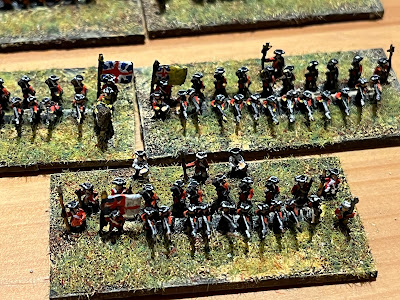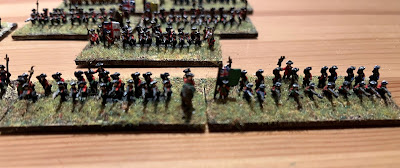Off the painting table today (well yesterday now) come five bases of infantry and two of cavalry. Whilst 2 bases represent a 'brigade' in TOTSK, I've chosen to paint each base or pair of bases as representatives of one regiment.
One thing I've noticed that makes all the difference when painting these fiddly figures is to paint the hat lace. It needs a steady hand (I have shaky hands so I push my wrists into something like the edge of the desk) and paint of just the right consistency to flow on easily without going on too easily. It doesn't need to go all round the hat properly, and it doesn't even need to be in the right spot. Just the hint of a triangular shape will create a decent impression for the typical tabletop view. Another thing I could do is get some silver paint for the swords, musket barrels and bayonets rather than the natural steel colour I'm using.
So now the total musters:
2nd Foot Guards (Coldstream)*
11th Foot (later the Norfolk Regiment)
12th Foot (later the Suffolk Regt)
23rd Foot (Royal Welch Fusileers), 1 base only
33rd Foot (later the Duke of Wellington's (West Riding) Regt), 1 base only
42nd Foot (The Black Watch), 1 base only
Combined grenadiers, 1 base only (2 battalions in TOTSK)
Royal Horse Guards (The Blues)
2nd (Royal North British) Dragoons (The Scots Greys), 1 base only**
15th (Light) Dragoons (later the 15th, King's, Hussars), 1 base only
3 General/staff group bases
So a total of 10 foot and 4 cavalry bases (5 and 2 brigades respectively).
I plan to do four more bases of British cavalry next. I fact they should be done tomorrow. Then it's a toss up between Hanoverians or more French.
Update
A quick check showed that I had enough British infantry and cavalry done for Minden. Slightly too many in fact. So those two brigades of cavalry in red coats waiting to be finished would have to be Hanoverians. No wait a minute, they wore white coats. OK, French then. There were ten squadrons of Gendarmerie who wore red. That’ll do for one brigade in red then. There might be more, but I already have a bunch of red coated French cavalry. More checking needed.
So, wishing to crack on and do something, rather than spend more time checking what I should do, I painted up two bases of horse grenadiers as Regiment Raugrave who were also at Rossbach (but didn’t feature in any of my games as such). Job done, and glued to their bases with a coating of chinchilla dust for texture. Tomorrow should see the basing finished. Despite wearing bearskins I don’t think they were particularly good, just ordinary line cavalry not in tricornes.
I’ve got 30 squadrons worth of cavalry (six bases/three brigades) stuck on lolly sticks ready for undercoating. These will be the Hanoverian cavalry. Not sure if I’ll get these finished in the next couple of weeks though as I have a long work trip coming up. Time being sociable with the Margravina is important at the moment (the lady being particularly attached to your correspondent, much to his evident pleasure) so time available for marshalling one’s forces is at a premium. Affairs of state must be balanced with affairs of the heart.
* I couldn't make my mind up which of the three Foot Guards regiments to do, so I took the average and did the 2nd.
** I decided on a whim to convert an already painted base from the Horse Grenadiers to the Scots Greys and dabbed white paint on the horses at the last minute.
Blogger is having one of its glitchy spells again, buggering up the positions of the pictures.
 |
| Top down view of 33rd, and 12th Foot |
 |
| The Royal Horse Guards. Bases to be completed |
33rd, 12th, 23rd and Combined Grenadiers
11th Foot


Very nicely done. I am interested in your comment on the hats as I have a 10mm army in my painting pile that will need their hats done. The idea of just giving the impression sounds right up my level of painting - which is not great on detail work 😁
ReplyDeleteThanks Ben. I am definitely an ‘Impressionist’ when it comes to painting figures! Will be interested in seeing your 10mm army. I find 10mm slightly harder than 6mm somehow.
DeleteChris
Very nice work there Chris!
ReplyDeleteCheers Ross.
DeleteChris
Fine work there Chris and even in 10mm, hat lace is a challenge with my rather shaky painting hand. Like you I tend to try and anchor it somewhere to minimise the tremors. Using the side of the brush rather than the tip helps too, something I picked up from a fried a good few years ago now.
ReplyDeleteThanks Steve. Yes, good point about the side of the brush. I do the same. The movement is easier to control for some reason. It also involves angling the figure/brush so the brush touches the head in the right place. Crikey, there’s a lot that I do without being fully conscious of until I really think about it.
DeleteChris
Blogger is allowing me to comment on blogs today, so may I just say these guys look great. The Hat Lace Syndrome came as something of a shock to me in recent years. I found the best approach for me was to paint the lace "there or thereabouts", and then clean it up quickly with hat black - it's a small extra effort, and it does wonders for my wobbly lines. My chaps, of course, are 20mm, which is probably easier.
ReplyDeleteCheers Tony. They look alright en masse from above. They don’t bear close up examination.
DeleteI’ve used the same method myself, on an ad hoc basis when the ‘lace’ has been laid on particularly thick. At scale this would probably be about a foot!
Chris
Fast work, Chris! Hat lace. Yeah, it is a pain but without it, the units do not have the same ‘pop!’ I use Tony’s tip often.
ReplyDeleteI use a batch system, starting with a mass spray undercoat session, then faces on all (14 units). Then I did all the Brits’ coats (7 units). Then I narrow it down to a few units. So I’m never very far from finishing off a unit. Once the next two cavalry units are done, there’ll be a bigger gap.
DeleteChris
They look very good, Chris!
ReplyDeleteThank you kindly sir!
DeleteChris
Nice looking units and I like the way you have done the bases.
ReplyDeleteThanks Peter. The basing method is taken from the guide on the Baccus website.
DeleteChris